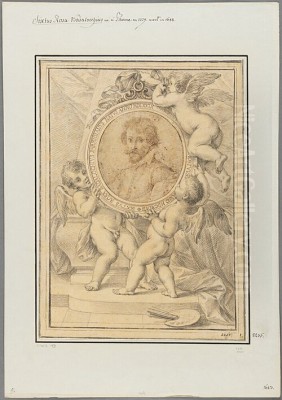
Sisto Badalocchio Rosa (1581/1585 – c. 1619/1647) stands as a significant, if sometimes overlooked, figure in the vibrant landscape of early seventeenth-century Italian art. A painter and etcher of considerable talent, he was an important member of the Bolognese School, a movement that sought to reform the prevailing Mannerist style and inject new vigor into painting through a return to naturalism and the classical ideals of the High Renaissance. Born in Parma, a city with its own rich artistic heritage, Badalocchio's career would see him traverse the artistic centers of Bologna and Rome, contributing to some of the era's most ambitious projects and leaving behind a body of work that, while not as extensive as some of his contemporaries, reveals a distinct artistic personality and a crucial role in the dissemination of the burgeoning Baroque style.
Early Life and Artistic Formation in Parma and Bologna
The precise birth year of Sisto Badalocchio is subject to some scholarly debate, with sources suggesting either 1581 or 1585. Regardless, his formative years were spent in Parma, a city dominated by the artistic legacy of Antonio Allegri da Correggio and, to a lesser extent, Parmigianino. Correggio's masterful use of sfumato, his dynamic and illusionistic dome frescoes, and the tender grace of his figures would have been an inescapable influence on any aspiring artist in Parma. This early exposure to Correggio's sensuous and emotive style likely laid a foundation for Badalocchio's own later development.
His formal artistic training began in earnest when he moved to Bologna to study at the Accademia degli Incamminati (Academy of the Progressives, or Wayfarers), founded by the Carracci family: Ludovico, Agostino, and Annibale. This academy was a crucible of artistic reform, emphasizing drawing from life, the study of High Renaissance masters like Raphael and Titian, and a balanced approach that combined Venetian colorito with Florentine-Roman disegno. It was here that Badalocchio would have absorbed the core tenets of what became known as the Bolognese School.
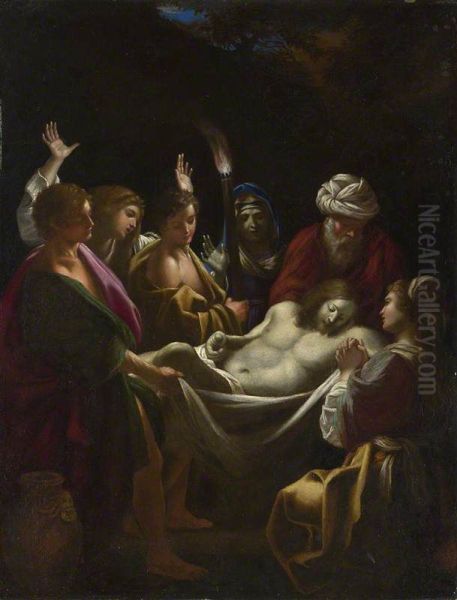
Around 1600, Badalocchio returned to Parma, where he became a pupil of Agostino Carracci. Agostino, himself a renowned painter and a particularly gifted engraver, had been called to Parma by Duke Ranuccio I Farnese to work on the decoration of the Palazzo del Giardino. Badalocchio's time with Agostino would have been crucial, not only for honing his painting skills but also for introducing him to the intricacies of printmaking, a medium in which Badalocchio would later excel.
The Roman Sojourn: Collaboration and Growth
The death of Agostino Carracci in 1602 marked a turning point. Recognizing the talent of Badalocchio and his fellow student and close associate, Giovanni Lanfranco (born in Parma around the same time as Badalocchio), Duke Ranuccio I Farnese dispatched them to Rome. Their mission was to continue their artistic education under the guidance of Agostino's brother, Annibale Carracci, who was by then a dominant figure in the Roman art scene, most famous for his monumental fresco cycle in the Farnese Gallery.
In Rome, Badalocchio and Lanfranco became integral members of Annibale Carracci's workshop. They assisted the master on several significant commissions. While the Farnese Gallery was largely completed by their arrival, they likely contributed to its final stages or related projects. More definitively, they are known to have worked with Annibale on the decoration of the Herrera Chapel in the church of San Giacomo degli Spagnoli. This period was immensely formative, exposing Badalocchio to the grandeur of Roman classicism, the works of Raphael and Michelangelo, and the dynamic artistic environment of the papal city, where artists like Caravaggio were forging a revolutionary path with his dramatic naturalism.
Badalocchio's collaboration with Annibale Carracci was not limited to painting. He was involved in projects that aimed to disseminate the Carracci style and the legacy of High Renaissance art. This is most evident in his work as an etcher.
Master of the Etching Needle: The Raphael Bible and Other Prints
Sisto Badalocchio distinguished himself as a skilled etcher, a medium that gained increasing prominence in the 17th century for its ability to reproduce and circulate artistic ideas. His most famous undertaking in this field was the series of etchings known as the "Raphael Bible" (Biblia Sacra, vulgo Raffaelli). Created in collaboration with Giovanni Lanfranco and published in 1607, this series reproduced the frescoes designed by Raphael and executed by his workshop in the Vatican Logge. These prints were dedicated to Annibale Carracci and played a vital role in popularizing Raphael's compositions throughout Europe, making them accessible to a wider audience of artists and connoisseurs.
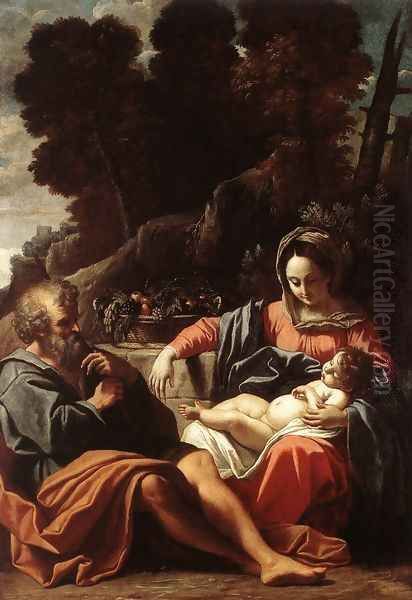
The Raphael Bible etchings demonstrate Badalocchio's sensitivity to line and his ability to translate the complex narratives and figural arrangements of Raphael's frescoes into the more intimate medium of print. His etching style, influenced by Agostino Carracci's own refined graphic work, is characterized by a fluid, painterly quality. Beyond this major collaborative project, Badalocchio produced other etchings, often of religious subjects, such as The Holy Family with the Young St. John, which showcases his delicate touch and ability to convey tender emotion. These prints further underscore his commitment to the classical ideals championed by the Carracci.
Return to Emilia and Independent Commissions
Following Annibale Carracci's incapacitating illness around 1605 and his eventual death in 1609, Badalocchio's path diverged somewhat from that of Lanfranco, who would go on to achieve greater fame in Rome and Naples. Badalocchio returned to the Emilia region, primarily working in Parma and Reggio Emilia. This period saw him undertake significant independent commissions, allowing his personal style to mature further.
One of his most important projects from this era was the fresco decoration in the Church of San Giovanni Evangelista in Reggio Emilia, executed around 1613. Here, he painted the dome and the pendentives. The dome depicted the Glory of Angels, while the pendentives featured scenes from the life of St. John the Evangelist. These frescoes are particularly notable for their reinterpretation of Correggio's illusionistic dome paintings in Parma, such as those in the same-named San Giovanni Evangelista in Parma and the Parma Cathedral. Badalocchio sought to emulate Correggio's soaring perspectives and soft, atmospheric effects, but infused them with a more robust, Carraccesque classicism and a burgeoning Baroque dynamism. This demonstrates his deep understanding of his Parmesan artistic heritage, filtered through his Roman and Bolognese experiences.
Other notable paintings from his career include Christ Carried to the Tomb (c. 1610, Galleria Borghese, Rome), a work praised for its poignant emotionality and dramatic use of chiaroscuro, reminiscent of Ludovico Carracci's pathos. The Holy Family (various versions exist, including one in the Wadsworth Atheneum, Hartford) and The Coronation of the Virgin (Galleria Nazionale, Parma) further exemplify his skill in handling religious narratives with grace and sensitivity. His St. John, also in the Galleria Nazionale, Parma, showcases his ability to create powerful, solitary figures.
Artistic Style, Technique, and Influences
Sisto Badalocchio's artistic style is a compelling synthesis of various influences, characteristic of the eclectic yet innovative spirit of the Bolognese School. At its core, his work is rooted in the Carracci reform, emphasizing strong drawing, clear composition, and a return to naturalism. However, his Parmesan origins imbued his art with a particular softness and a sensitivity to color and light, likely inherited from Correggio.
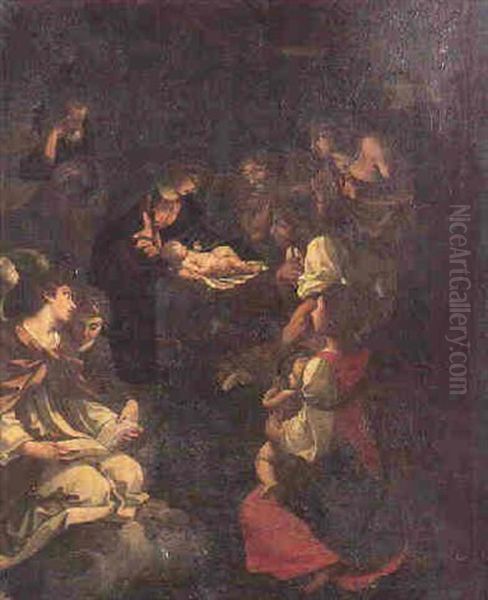
His Roman experience under Annibale Carracci solidified his classical tendencies, evident in the balanced compositions and idealized figure types found in many of his works. Yet, he was not immune to the broader currents of the early Baroque. His paintings often exhibit a heightened emotional intensity, dynamic movement, and a sophisticated use of light and shadow (chiaroscuro) to create dramatic effects and model form. This is particularly apparent in works like Christ Carried to the Tomb, where the interplay of light and dark enhances the scene's tragic mood.
Compared to his contemporary and collaborator Giovanni Lanfranco, who fully embraced the High Baroque's theatricality and energetic dynamism, Badalocchio's style often retained a more lyrical and restrained quality. While Lanfranco's career soared to greater heights, particularly with large-scale illusionistic ceiling frescoes like that in Sant'Andrea della Valle in Rome, Badalocchio's contributions were more focused on easel paintings, smaller-scale frescoes, and his significant work in etching.
His engagement with the art of Correggio in his Reggio Emilia frescoes is a testament to his ability to look back to earlier masters and reinterpret their achievements within a contemporary framework. He was not merely an imitator but an artist who could absorb and transform influences. Other artists from the Bolognese sphere, such as Guido Reni, Domenichino, and Francesco Albani, each developed their own distinct variations of the Carracci legacy, with Reni known for his elegant classicism, Domenichino for his compositional clarity and emotional depth, and Albani for his charming mythological scenes. Badalocchio's work shares with these artists a commitment to beauty and expressive clarity, though his career path led him away from the major centers where they achieved their greatest fame.
The Enigma of His Later Years and Death
One of the persistent questions surrounding Sisto Badalocchio is the date of his death. Older sources often cite a date around 1647, suggesting a longer, though perhaps less documented, later career. However, more recent scholarship, notably advanced by art historian Donald Posner, suggests that Badalocchio may have died much earlier, possibly as early as 1619 or shortly thereafter. This earlier death date would significantly reframe our understanding of his oeuvre, concentrating his activity into a more intense, albeit shorter, period.
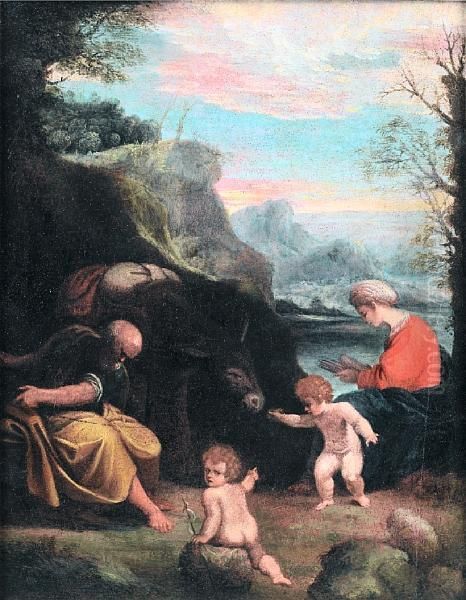
If he did die around 1619, it would mean his most significant works, including the Reggio Emilia frescoes and his key etchings, were produced within a relatively compact timeframe. This would also explain the comparative scarcity of later works and the fact that his fame was somewhat eclipsed by contemporaries like Lanfranco, who had longer and more prominent careers in major artistic centers. The lack of extensive documentation for his later life contributes to this uncertainty. Regardless of the precise date, his active period seems to have been primarily in the first two decades of the 17th century.
Legacy and Significance
Sisto Badalocchio's importance in the history of Italian Baroque art lies in several key areas. Firstly, as a product of the Carracci Academy and a collaborator with both Agostino and Annibale, he was a direct inheritor and propagator of their artistic reforms. His work embodies the Bolognese School's emphasis on naturalism, classicism, and emotional expressiveness.
Secondly, his collaboration with Giovanni Lanfranco, particularly on the Raphael Bible etchings, was a significant cultural endeavor. These prints played a crucial role in the dissemination of High Renaissance ideals and provided invaluable visual resources for artists across Europe. His skill as an etcher contributed to the growing importance of printmaking as an art form and a means of artistic communication. Artists like Stefano della Bella and Jacques Callot would later expand the expressive possibilities of etching.
Thirdly, Badalocchio is considered an important figure in bringing the early Roman Baroque style to Northern Italy, particularly to Emilia. His frescoes in Reggio Emilia, for instance, demonstrate a fusion of local traditions (the influence of Correggio) with the lessons learned in Rome. He helped to update and invigorate the artistic language of his native region.
While he may not have achieved the same level of fame as some of his more celebrated contemporaries like Lanfranco, Domenichino, or Guido Reni, or the revolutionary impact of Caravaggio, Sisto Badalocchio was a talented and dedicated artist who made substantial contributions to the artistic currents of his time. His paintings are characterized by their sensitivity, their skilled handling of light and color, and their sincere emotional appeal. His etchings remain a testament to his graphic skill and his commitment to the classical tradition.
In conclusion, Sisto Badalocchio was more than just a minor follower of the Carracci. He was an active participant in the artistic dialogues of the early 17th century, a skilled practitioner in both painting and etching, and a vital link in the transmission of artistic ideas between Rome and Northern Italy. His work merits continued attention for its intrinsic quality and for the light it sheds on the complex and dynamic art world of the early Italian Baroque, an era that saw the legacy of masters like Titian, Veronese, and Tintoretto transformed by a new generation seeking to balance nature, classicism, and dramatic expression. Badalocchio, in his own distinct way, was a part of this transformative moment.